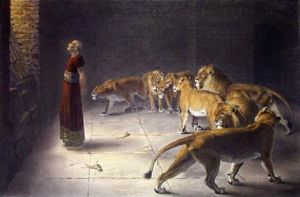Daniel
Daniel (Hebrew: transliterated as Daniyyel in Standard Hebrew and Dāniyyêl in Tiberian Hebrew, Arabic: Danyel), is the name of at least three people from the Hebrew Bible:
- 1. A Jewish exile in Babylon, the subject of the Book of Daniel and the most well-known of the three Daniels.
- 2. David's second son, "born unto him in Hebron, of Abigail the Carmelitess" (1 Chronicles 3:1). He is called also Chileab (2 Samuel 3:3).
- 3. A legendary figure known for his wisdom and righteousness (see section Reference in Ezekiel)
The name means "My judge is Elohim," or "Elohim has judged."
Daniel's Life
Daniel was descended from one of the noble families of Judah (Daniel 1:3), and was probably born in Jerusalem about B.C. 620, during the reign of Josiah.
At the first deportation of the Jews by Nebuchadnezzar (the kingdom of Israel had come to an end nearly a century before at the hands of the Assyrians), or immediately after his victory over the Egyptians at the second battle of Carchemish, in the fourth year of the reign of Jehoiakim (B.C. 606), Daniel and three other noble youths were among the Jewish young nobility carried off to Babylon (probably as hostages to ensure the loyalty of Judah's king and advisors), along with some of the vessels of the temple. Daniel and his three Jewish companions were subsequently evaluated and chosen for their intellect and beauty, to be trained as Chaldeans (members of the class of the magi: astrologers, sorcerers, enchanters and magicians), who constituted the ranks of the advisors to the Babylonian court.
There Daniel was obliged to enter into the service of the king of Babylon, and in accordance with the custom of the age, received the Chaldean name of Belteshazzar, i.e., prince of Bel, or Bel protect the king! His residence in Babylon was very probably in the palace of Nebuchadnezzar, now identified with a mass of mounds called the Kasr, on the right bank of the river. However, Daniel and his three companions remained fiercely loyal to their Jewish religious and cultural identity, an identity which would sooner or later come into conflict with the paganism of the Babylonian court.
Daniel's training in the schools of the "magi" in Babylon (Daniel 1:4) was to fit him for service to the empire. Daniel became distinguished during this period for his piety, and for his strict observance of the Torah, or Mosaic law (1:8-16), and gained the confidence and esteem of those who were over him.
At the close of his three years of discipline and training in the royal schools, Daniel was distinguished for his proficiency in the pagan "wisdom" of his day, and was brought out into public life. He soon became known for his "skill" (a gift from YHWH) in the interpretation of dreams (1:17; 2:14), and rose to the rank of governor of the province of Babylon, and became "chief of the governors" (Chald. Rab-signin) over all the wise men of Babylon, after passing a dangerous test of the astrologers by the king, which could easily have cost Daniel his life.
Prophetic Skills
Daniel made known and also interpreted Nebuchadnezzar's dream; as well as a later dream preceding the king's descent into animal behaviour, and many years afterwards, when he was now an old man, amid the alarm and consternation of the terrible night of Belshazzar's impious feast (in which Belshazzar and his concubines drank wine out of the royal Jewish ceremonial goblets of the Temple), Daniel was called in at the suggestion of the queen-mother (perhaps Nitocris, the daughter of Nebuchadnezzar) to interpret the mysterious handwriting on the wall. For successfully reading the cryptic handwriting by an angel of God, Daniel was rewarded by the Babylonians with a purple robe and elevation to the rank of "third ruler" of the kingdom. The place of "second ruler" was held by Belshazzar as associated with his father, Nabonidus, on the throne (5:16). Daniel interpreted the handwriting, and "in that night was Belshazzar the king of the Chaldeans slain" by his own sons, who later fled.
Daniel's Tomb
A tomb said to be the last resting place of the prophet Daniel is located in the Kirkuk Citadel in the city of Kirkuk in Iraq. There is a mosque built on the tomb, the mosque has arches and pillars and two domes on a decorated base and beside it there are three minarets belonging to the end of the Mongolian reign. The mosque is about 400 square meters, it has four illusions tombs of Daniel, Hannah, Ezra and Michael. Another tomb in Susa, Iran, also claims to be that of Daniel.
